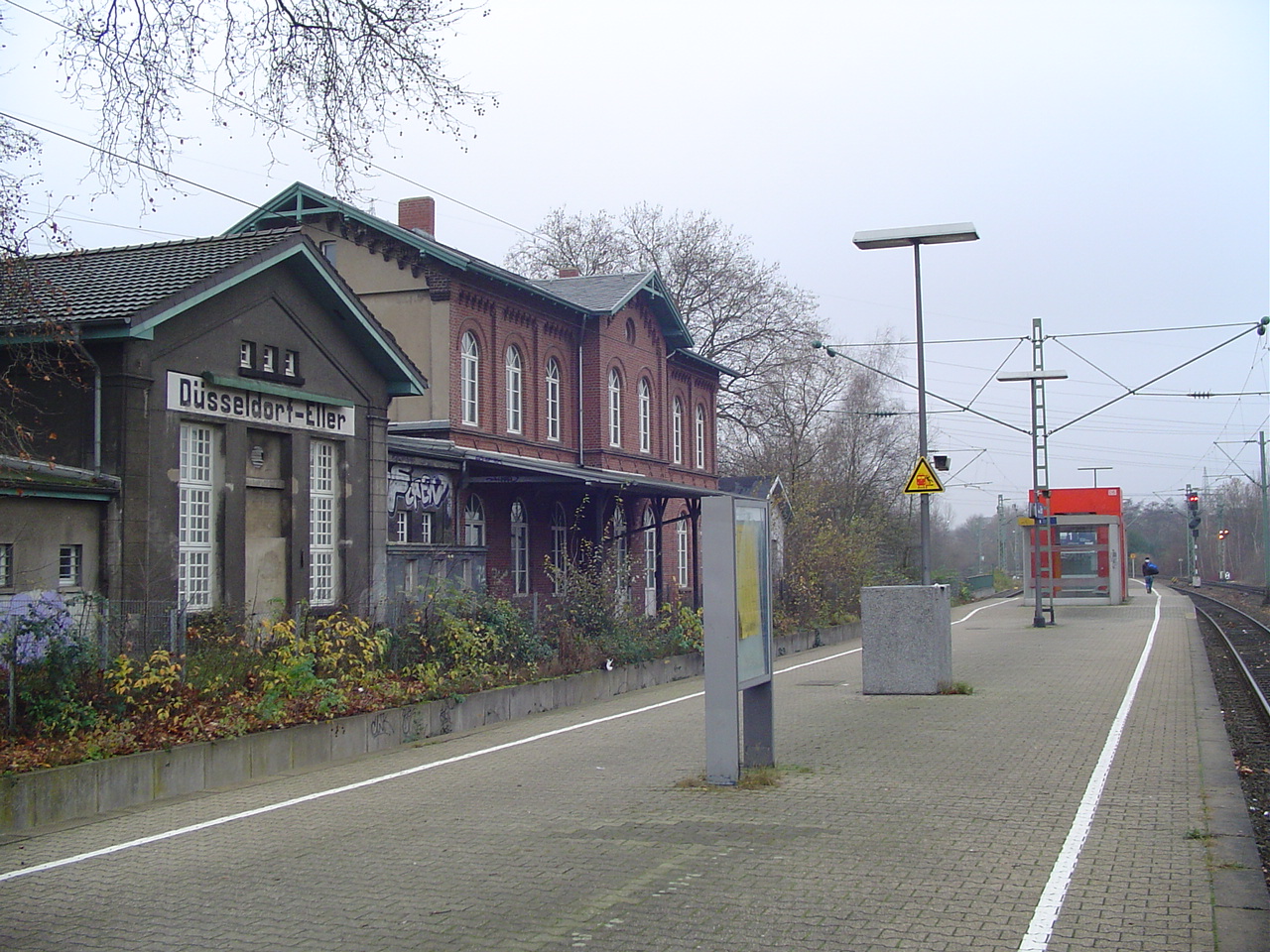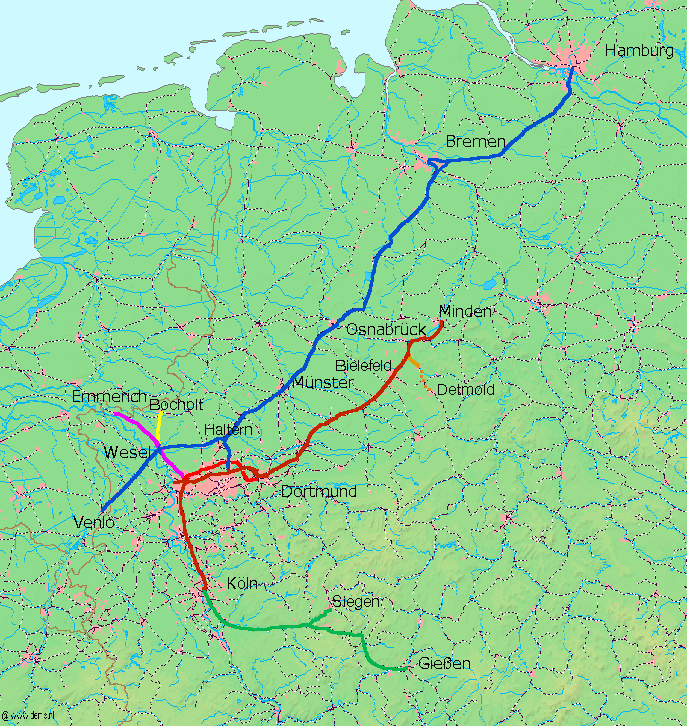|
S1 (Rhine-Ruhr S-Bahn)
Line S1 is a S-Bahn line on the Rhine-Ruhr network. It is operated by DB Regio. It runs from Dortmund via Bochum and Essen to Duisburg. From there it travels south to Düsseldorf and Hilden before continuing to Solingen. It is operated on weekdays at 15-minute intervals between Dortmund Hbf and Essen Hbf, at 20-minute intervals between Düsseldorf Hbf and Solingen and at 30-minute intervals between Düsseldorf and Essen, using coupled sets of class 422 four-car electrical multiple units. Line S 1 runs over lines built by various railway companies: * from Dortmund Hauptbahnhof to Duisburg over the Witten/Dortmund–Oberhausen/Duisburg railway, opened by the Bergisch-Märkische Railway Company in 1862, * from Duisburg to Düsseldorf-Oberbilk over the Cologne–Duisburg railway, opened by the Cologne-Minden Railway Company in 1845 and * from Düsseldorf-Oberbilk to Solingen over the Düsseldorf–Solingen railway opened by the Prussian state railways between 1891 and 1894. S-Bah ... [...More Info...] [...Related Items...] OR: [Wikipedia] [Google] [Baidu] |
Essen Hauptbahnhof
Essen Hauptbahnhof (German for "Essen main station") is a railway station in the city of Essen in western Germany. It is situated south of the old town centre, next to the A 40 motorway. It was opened in 1862 by the Bergisch-Märkische Eisenbahn. However, the station was not the first in Essen: as the station called ''Essen'' (today Essen-Altenessen) on the Köln-Mindener Eisenbahn was opened in 1847. The station suffered extensive damage in World War II and was almost completely rebuilt in the 1950s and 1960s. During the following years, the Essen Stadtbahn and the A 40 were other construction projects affecting the station. Today it is an important hub for local, regional and long-distance services, with all major InterCityExpress and InterCity trains calling at the station as well as RegionalExpress and Rhein-Ruhr S-Bahn services. Trains of all kinds call at the station, from long distance to local services. It used to be one of the Metropolitan stops on the Hamburg to Co ... [...More Info...] [...Related Items...] OR: [Wikipedia] [Google] [Baidu] |
Witten/Dortmund–Oberhausen/Duisburg Railway
The Witten/Dortmund, Oberhausen/Duisburg railway is one of the most important railways in Germany. It is the main axis of long distance and regional rail transport on the east–west axis of the Ruhr and is served by Intercity-Express, InterCity, Regional-Express, Regionalbahn and S-Bahn trains. Strictly speaking, the line today consists of two parallel two-track lines, one for mainline trains and the other for S-Bahn trains. On several sections of the line the long-distance tracks and S-Bahn tracks follow separate routes. The long-distance tracks follows the historical route built between 1860 and 1862 by the Bergisch-Märkische Railway Company as an extension of its trunk line between Elberfeld and Dortmund. History The Cologne-Minden Railway Company (German, old spelling: ''Cöln-Mindener Eisenbahn-Gesellschaft'', ''CME'') planned the route of its trunk line, built from 1845 to 1847, to avoid the construction costs of a line through the very hilly land along the valleys ... [...More Info...] [...Related Items...] OR: [Wikipedia] [Google] [Baidu] |
S7 (Rhine-Ruhr S-Bahn)
Line S 7 is an S-Bahn line on the Rhine-Ruhr network in the German state of North Rhine-Westphalia, which has been operated by VIAS GmbH from Wuppertal Hauptbahnhof to Solingen Hauptbahnhof since 15 December 2013. It is operated at 20-minute intervals, using LINT 41 vehicles. The service was previously classified as Regionalbahn service RB 47, known as the ''Der Müngstener'', a reference to the Müngsten Bridge, which it crosses and DB Regio had operated it on the same route with class 628 diesel multiple units since 1994. It was also operated at 20-minute intervals, in the evenings and on weekends, every 30 minutes. Line S 7 runs over lines built by two railway companies: * from Wuppertal Hauptbahnhof to Wuppertal-Oberbarmen station over the Elberfeld–Dortmund railway, opened by the Bergisch-Märkische Railway Company in 1847 and 1849, * from Wuppertal-Oberbarmen to Solingen Hauptbahnhof over the Wuppertal-Oberbarmen–Solingen railway, opened in sections by the Bergisch- ... [...More Info...] [...Related Items...] OR: [Wikipedia] [Google] [Baidu] |
Düsseldorf Airport Terminal Station
Düsseldorf Airport Terminal (''Düsseldorf Flughafen Terminal'') is an underground station on the Rhine-Ruhr S-Bahn at the end of the Düsseldorf-Unterrath–Düsseldorf Airport Terminal railway, situated underneath Terminal C of Düsseldorf Airport, Düsseldorf Düsseldorf ( , , ; often in English sources; Low Franconian and Ripuarian: ''Düsseldörp'' ; archaic nl, Dusseldorp ) is the capital city of North Rhine-Westphalia, the most populous state of Germany. It is the second-largest city in th ... in western Germany. It is served by the S11 line. The station was opened in 1975 and was served by S-Bahn line S 7 until 13 December 2009, when line S 7 was closed and S 11 was extended to Düsseldorf Airport Terminal station. Notes Railway stations in Düsseldorf Railway stations located underground in Germany Rhine-Ruhr S-Bahn stations Airport railway stations in Germany S11 (Rhine-Ruhr S-Bahn) Düsseldorf Airport Railway stations in Germany opened in 1975 ... [...More Info...] [...Related Items...] OR: [Wikipedia] [Google] [Baidu] |
Duisburg-Großenbaum Station
Duisburg-Großenbaum station is a station in the district of Großenbaum of the city of Duisburg in the German state of North Rhine-Westphalia. It is on the Cologne–Duisburg railway and it is classified by Deutsche Bahn as a category 5 station. The station was opened on 9 February 1846 as ''Großenbaum''. It was renamed ''Duisburg-Großenbaum'' on 14 May 1950. A station building was built in 1856, but it is now used as a cafe, called ''Gleis drei'' (track three). The station is served by Rhine-Ruhr S-Bahn line S 1 (Dortmund–Solingen) every 20 minutes during the day on week days, every 30 minutes on weekends between Essen and Düsseldorf Düsseldorf ( , , ; often in English sources; Low Franconian and Ripuarian: ''Düsseldörp'' ; archaic nl, Dusseldorp ) is the capital city of North Rhine-Westphalia, the most populous state of Germany. It is the second-largest city in th .... It is also served by three bus routes operated by ''Duisburger Verkehrsgesellschaft'' at ... [...More Info...] [...Related Items...] OR: [Wikipedia] [Google] [Baidu] |
Prussian State Railways
The term Prussian state railways (German: ''Preußische Staatseisenbahnen'') encompasses those railway organisations that were owned or managed by the State of Prussia. The words "state railways" are not capitalized because Prussia did not have an independent railway administration; rather the individual railway organisations were under the control of the Ministry for Trade and Commerce or its later offshoot, the Ministry for Public Works. The official name of the Prussian rail network was ''Königlich Preußische Staatseisenbahnen'' (K.P.St.E., "Royal Prussian State Railways") until 1896, ''Königlich Preußische und Großherzoglich Hessische Staatseisenbahn'' (K.P.u.G.H.St.E., " Royal Prussian and Grand-Ducal Hessian State Railways") until the end of the First World War, and ''Preußische Staatsbahn'' (P.St.B., "Prussian State Railway") until its nationalization in 1920. A common mistake is the use of the abbreviation K.P.E.V. in supposed reference to a mythical "Royal Prussian ... [...More Info...] [...Related Items...] OR: [Wikipedia] [Google] [Baidu] |
Düsseldorf–Solingen Railway
The Düsseldorf–Solingen railway is a railway in the German state of North Rhine-Westphalia. It is a 19 kilometre line, entirely double track and electrified with overhead line. It is now exclusively used by line S 1 of the Rhine-Ruhr S-Bahn. History The section between Düsseldorf Hauptbahnhof and Düsseldorf-Eller was opened on 1 October 1891 by the ''Eisenbahndirektionen Cöln rechtsrheinisch'' ( Railway division of Cologne Rhine Right Bank of the Prussian state railways). Between Eller and Hilden the line originally used the Troisdorf–Mülheim-Speldorf line, which was opened by the Rhenish Railway Company on 18 November 1874, but separate tracks were opened in 1917. The section between Hilden and Ohligs (now Solingen Hauptbahnhof) was opened on 3 January 1894. Rail services S-Bahn services started operating over the line to Düsseldorf Airport Terminal on 27 October 1975; these services were eventually branded as line S 7. On 13 December 2009, line S 7 services we ... [...More Info...] [...Related Items...] OR: [Wikipedia] [Google] [Baidu] |
Cologne-Minden Railway Company
The Cologne-Minden Railway Company (German, old spelling: ''Cöln-Mindener Eisenbahn-Gesellschaft'', ''CME'') was along with the Bergisch-Märkische Railway Company and the Rhenish Railway Company one of the railway companies that in the mid-19th century built the first railways in the Ruhr and large parts of today's North Rhine-Westphalia. Founding The founding of the Cologne-Minden Railway Company in 1843 in Cologne ended a long struggle for a railway line between the Rhineland and the German North Sea ports, as well as the Prussian capital of Berlin. From the 1830s several railway committees in the cities of Düsseldorf, Cologne and Aachen attempted to find a solution with each other and the Prussian government. The focus of all these efforts was to avoid the Dutch duties on trade on the Rhine, which significantly increased the cost of import and export of goods via the Rhine. Some of the Cologne committee members under David Hansemann (1790–1864)—a merchant and banker fr ... [...More Info...] [...Related Items...] OR: [Wikipedia] [Google] [Baidu] |
Düsseldorf-Oberbilk Station
Düsseldorf-Oberbilk (Oberbilk Bf./PhilipsHalle for the subway station) is an interchange railway station situated at Oberbilk, Düsseldorf in western Germany. It is served by the S1, S6 and S68 lines of Rhine-Ruhr S-Bahn, , , 2011 lines U74, U77 and U79 of (light rail), and |
Bergisch-Märkische Railway Company
The Bergisch-Markisch Railway Company (german: Bergisch-Märkische Eisenbahn-Gesellschaft, BME), also referred to as the Berg-Mark Railway Company or, more rarely, as the Bergisch-Markische Railway Company, was a German railway company that together with the Cologne-Minden Railway (''Cöln-Mindener Eisenbahn-Gesellschaft'', ''CME'') and the Rhenish Railway Company (''Rheinische Eisenbahn-Gesellschaft'', ''RhE'') was one of the three (nominally) private railway companies that in the mid-19th century built the first railways in the Ruhr and large parts of today's North Rhine-Westphalia. Its name refers to Bergisches Land and the County of Mark. History Foundation The Bergisch-Markisch Railway Company was founded on 18 October 1843 in Elberfeld (Today Wuppertal). Since the Cologne-Minden Railway Company had decided to build its route via Duisburg rather than through the valley of the Wupper river, the Bergisch-Markisch Railway Company (german: Bergisch-Märkische Eisenbahn-Gesellscha ... [...More Info...] [...Related Items...] OR: [Wikipedia] [Google] [Baidu] |








